| |
|
| PHOTOSYNTHESIS
PAGES |
The
Busy Leaf |
|
|
|
 A
beautiful green summer leaf (I drew it myself with only two colored pencils).
A
beautiful green summer leaf (I drew it myself with only two colored pencils).
Warm summer days. The sun is shining. The leaves
are just hanging there, doing nothing but looking pretty and wiggling in the wind.
Wrong! It looks peaceful, but those leaves are busy.
At speeds almost beyond our comprehension, thousands of chemical reactions and
processes are occuring every second, inside thousands of cells.
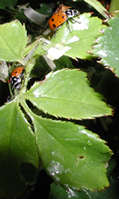
Busy, busy, busy, making stuff - carbohydrates that will
be the building blocks to make more plant cells and the energy source for all
the plant cell processes. This is photosynthesis.
Where does all this "photosynthesizing"
take place? Do all the leaf cells do it? Do they have to go to school to learn
how?
Naw, not all the leaf cells do it; and somehow,
like most other living things, they just know how to do what they do without going
to school. (In the case of plant cells, it's more like being programmed than "knowing".)
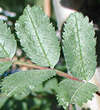
Keep scrolling down to get an overview of the places
and parts in a typical leaf where photosynthesis gets done. Then keep scrolling
down, or click on the specific words if you are the skipping type, to get a more
detailed look at the leaf parts and names and processes involved with turning
solar energy, water, and carbon dioxide, into food. |
|
|
 |
 |
 |
 |
 |
 |
|
|
|
| |
|
|
|
 |
 |
 |
| WHERE
IT HAPPENS IN A TYPICAL LEAF |
|
Part
1 - A Brief Overview |
 |
|
The
Leaf
It's
amazing what's inside a leaf. In this top section I'll give an overview of the
leaf parts involved in photosynthesis. In the section below, we'll go into more
detail.
The whole leaf looks green to us, but most of the
cells and cell material are colorless or clear. The green color comes from the
chlorphyll molecules in the chloroplasts.
Except for the thylakoid membranes,
where the clorophyll molecules reside, the rest of my colors are just there to
help you see the parts, and to make pretty pictures. |
| |
Leaf
Section
Cut
out a little section of the leaf. Cut it all the way through. There are many different
types of cells, specialized to do different things - all for the good of the tree,
of course.
On the top and bottom are the cuticle layer and
the epidermal cells.
In the middle, between the epidermis cells on the
top and bottom, are the mesophyll cells where the chloroplasts live.
On the bottom only, in most plants, are the stomates
which let carbon dioxide in and oxygen out. |
| More
on the Leaf Section |
| |
Mesophyll
Cells
No,
it's not a "Mess of Phils". It's a mesophyll.
The chloroplasts, where photosynthesis occurs, are
in the mesophyll cells.
There are two kinds of mesophyll cells in
our typical leaf. The ones you see in the leaf section above, packed close
together, are in the palisade parenchyma region (I can't say it
either - that's biologists for you). This is where most photosynthesis
is done. The other region is called the spongy parenchyma
region. Here the cells aren't so close. There are roomy air spaces
between them. Jump on down to the leaf section below for the
purpose of the air spaces. |
| |
Chloroplast
Now
we're getting to some small plant parts. But you can still see chloroplasts
with a regular microscope. Inside the chloroplasts, in the stoma and the grana,
is where photosynthesis happens (see below).
Promise me you will never forget the chloroplasts
- fascinating little "organelles" (why not organettes?) with their own
genetic material to make more of themselves.
Each chloroplast is a little carbohydrate factory,
powered by solar energy, and for which the only raw materials are carbon dioxide,
water, and a few minerals.
Out of this little factory comes food for plants
and practically every other living thing on earth - including us.
Good on yer, Chloroplast! |
| More
on the Industrious Chloroplast |
| |
Granum
The little round flat pillow or pancake shaped things
are called thylakoids. A stack of them is called a granum.
Two or more stacks are called grana (granums would have been too
easy).
There can be from 2 to around 100 thylakoids in
one granum. The little tube like strands connecting thylakoids from granum to
granum are called stroma lamellae (see the chloroplast
drawing below). |
| |
|
Thylakoid
Now
we have finally journeyed to the place where it all starts. The chlorphylls and
other pigments that start the process are here, on the outer layer of the thylakoids.
Photons from sunlight hit the pigments, electrons are "knocked" loose,
and off they go to energize the complicated process of photosynthesis.
Sometimes
the thylakoid is also called the photosynthetic membrane. That is easier for some
of us to remember. The membrane and the space inside it (shown in yellow), is
where the light or light-dependent reaction takes place. The so-called dark, or
light independent reactions, take place in the stroma (shown in gray here).
|
| |
|
| |
|
Back
to the Top of This Page |
 |
 |
 |
|
|
|
| |
|
|
|
|
 |
 |
 |
 |
 |
| |
|
| PART
2 - A MORE DETAILED LOOK AT THE LEAF |
Epidermis
and Cuticle:
Hmmm? Epidermis.
Sounds suspiciously like skin.
As must be obvious to you, it does act a lot like
skin. The epidermis cells on our leaf have stiff cell walls (which our skin doesn't).
They protect the leaf, help support it and give it shape, and they keep the moisture
inside. Plants can't do photosynthesis if all their water evaporates away. |
|
The
cuticle is a hard waxy water-tight material. It is the reason water beads up so
nicely on most leaves. Cuticle thickness is different in different plant species.
It is usually thickest in plants that live in deserts and semi-arid climates.
Why do you suppose that is?
The cuticle is made from a material secreted by
epidermis cells. |
|
Mesophyll
Cells:
Photosynthesis happens in chloroplasts,
and chloroplasts are in mesophyll cells. There can be from 1 to 50 or more chloroplasts
in a single mesophyll cell. The number varies with the plant species, age, and
health of the cell.
Continued
below... |
|
 |
 |
 |
|
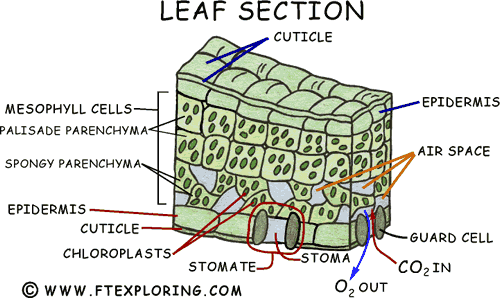 |
|
|
| TRANSPORTATION |
In
most plants, leaves are the main place where food is made. In order to do this,
there has to be a way to move the water and minerals to the leaf cells doing photosynthesis,
and a way to carry the food to other parts of the plant. A lot of water has to
be delivered because most of it is lost by evaporation through the stomas.
The transportation of water, food, and minerals
is done by the veins, which are not shown in the drawing to the left. But you
can see the big ones in the leaf drawing at the top of the page. |
|
Mesophyll
Cells Continued:
The
close packed cells right under the top epidermis are in the palisade parenchyma
region. The cells in this area generally have the most chloroplasts.
The
palesade region is photosynthesis central, where most carbohydrate
making takes place. There are small tight air spaces around these cells.
In the other region, called the spongy parenchyma
region (don't blame me, I don't pick the names), the cells seem more loosely placed
and irregularly shaped. The air spaces here are large and spacious - where the
rich folk would live if rich folk lived in mesophyll cells.
Air
Spaces:
You might call it breathing. Biologists like to
call it gas exchange. We animals breath in oxygen and breath out
carbon dioxide. Plants, and other autotrophs, do that too (really they do), but
they also need to do the opposite, get carbon dioxide in and oxygen out.
All of these gas molecules get in and out through
holes called stomas (see below). Then they flow into the roomy air passages
of the spongy parenchyma region. These passages are all connected
to each other and to the mesophyll cells. So this is where the gas molecules
get into and out of the photosynthesis "factory" cells.
|
|
Air
Spaces cont....
This region of the mesophyll cells, then, is sort of, but not exactly, like our
lungs and is a vital part of the photosynthesis activities of the leaf.
Stomate:
The combination of guard
cells and stoma is called the stomate. The stoma is just what they call the opening
that connects the outside to the inside. Air flows into the air spaces through
the stoma. The air brings carbon dioxide (CO2), needed for photosynthesis,
with it. Oxygen (O2), a byproduct of photosyntheis, flows out through
the stoma. CO2 given off by the plant as a result of repiration, may
also flow out through the stoma; or it may get reused for photosynthesis.
Guard
Cells:
No air passes in or out unless the guard cells say
so. Perhaps "Gate Keeper" cells would be a better name. They don't have
muscles, but they can open and close. Fluid pressure is used to make the cells
open and close the stoma.
|
|
Guard
Cells cont...
In a typical leaf, the guard cells are open during
the day and closed at night. This can be a problem for the plants on hot dry days,
because too much water is transpired, or evaporated, through the stomates. Loss
of water slows down photosynthesis.
Some
plants close their stoma on hot dry days, but this also slows photosynthesis,
because the cells begin to run short of carbon dioxide.
Other
plants, like the thorny cacti (more than one thorny cactus) that tend to live
in extremely dry climates, have adapted by always closing the openings during
the hot day time to reduce transpiration and water loss. At night
when it is cooler, the stomas are opened and gas exchange takes place with less
water loss.
These plants have to make some compromising changes
in the way they conduct photosynthesis for this to work. It makes them a little
less efficient in some ways, but it
allows them to store water for long dry spells and to live in conditions that
would kill other plants. They've got a good niche going.
Guard cells, like the mesophylls, can have a few
chloroplasts in them. No sense wasting a perfectly good solar energy collecting
surface. Guard cells want to contribute in any way they can.
|
|
| |
Back
to Leaf Overview |
Back
to Top of This Page |
 |
 |
 |
|
 |
 |
 |
 |
| |
CHLOROPLAST |
|
The
Chloroplast At Last:
Now
we are finally getting to the place where photosynthesis actually happens - the
chloroplasts, each one a little carbohydrate factory.
They are each around 5 to 10 microns across (a micron
is 1 millionth of a meter). Up to 50 or more can be in some cells. Other cells
may have only one.
Each chloroplast has some, but not all of its own
genetic material needed to reproduce itself. |
|
Chloroplasts
cont....
Their genetic material is labeled in the drawing as the ribosomes and,
cleverly enough, "genetic material" (I'm good with nomenclature).
The rest of the chloroplast's DNA is in the mesophyll cell nucleus. This allows
the mesophyll cell to have some control in the making of its own chloroplasts.
|
|
Chloroplasts
cont....
When the busy chloroplasts really get going they
can make more carbohydrates than is needed just for the photosynthesis process.
This "excess" carbohydrate material gets stored in the little starch
grains until it is needed elsewhere. |
|
| |
|
|
 |
 |
 |
|
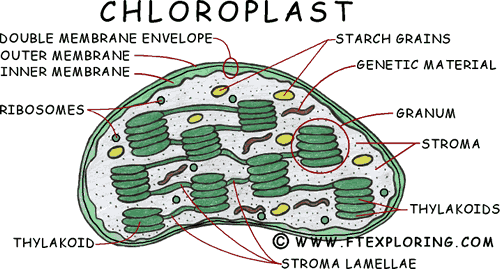 |
|
|
|
SOLAR
COLLECTERS
|
The
outer surfaces of the thylakoids and the lamellae connecting the thylakoids are
also called the photosynthetic membrane. This membrane contains the
pigment molecules of chlorophyll and carotenoid. These solar collector pigments
act like antennae to capture the solar energy and start the carbohydrate making
process we call photosynthesis.
They are spread around the chloroplast to provide
a lot of solar collecting surface area. |
|
Membrane
Envelople:
The membrane envelope holds it all together
and separates the chloroplast from the rest of the cell - duh! Well that's pretty
obvious but it does more. The inner envelope acts like a control gate and
regulator, controling the flow of necessary material and particles into, and out
of, the chloroplast. The small, simple, and very important molecules of stuff
like water (H2O), carbon dioxide (CO2), and oxygen (O2)
can pass through this membrane (going both ways - in and out).
|
|
Thylakoids:
The first part of the photosynthetic process, often called
the light reaction or light-dependant reaction, takes place in the
thylakoids. The thylakoids are stacked like pancakes or little pita breads (I
love pita bread), and connected to one another by the stroma lamellae
which are also part of the thylakoid membrane. The thylakoids and lamellae are
thought to be one big thing, just all spread out and all connected to each other
by the lamellae strands.
More on thylakoids and stroma
in the next section below. |
|
Stroma:
After the thylakoids, the photosynthesis process
moves out to the stroma. The stroma is where enzymes
take the carbon from carbon dioxide and combine it with hydrogen and oxygen to
make simple carbohydrate molecules. This part of the process is generally referred
to as the "light independent" reactions or "dark reactions".
More
on this process below... |
|
| |
Back
to Leaf Overview |
Back
to Top of This Page |
 |
 |
 |
|
 |
 |
 |
 |
| |
THYLAKOID |
|
The
Thylakoid:
This
is where the color comes from. The outer surface is called the thylakoid membrane
or the photosynthetic membrane. The pigment
and ATP Synthetase molecules are on the thylakoid membrane. Inside the
membrane is the thylakoid space.
Scientists generally break photosynthesis into two
stages, the light reactions and the dark reactions. |
|
The
light reactions, which are also called light dependent (because they depend
on light) or energy fixing (because they capture and make energy available
for the process) reactions, take place in the thylakoid space and the thylakoid
membrane.
Click on the underlined links for more info and definitions.
|
|
The
dark reactions, which are also referred to as the light independent (because
they don't need light) or carbon fixing reactions (because they "fix"
carbon from carbon dioxide into carbohydrate molecules), occur in the stroma
surrounding the thylakoids.
There are no little blue
men in the stroma. I just can't help myself sometimes. |
|
 |
 |
 |
|
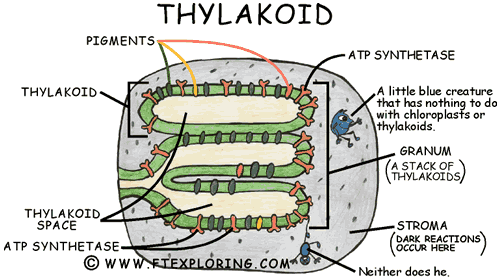 |
|
|
|
GRANUM
OR GRANA?
|
This
picture shows three thylakoids stacked one on top of the other. A stack of thylakoids
is called a granum.
More than one granum are grana. Apparantly,
the little green specks you see when you look at stacks of thylakoids through
a microscope, reminded someone of "grains" of something. If I had been
the first to look, we'd be calling them "pita" and "pitum",
'cause they make me think of pita bread. |
|
Light Dependent Processes:
The first stage of photosynthesis takes place in
the thylakoid membrane and the thylakoid space. The various types of chlorophyll
and carotenoid molecules are the pigments placed
in the membrane. These pigments start the process by acting sort of like antennae
that capture the solar energy. Light photons hit
the chlorophyll or carotenoid molecules. This photon energy "knocks loose"
an electron which provides the energy to other molecules to start the very complicated
and fascinating photosynthesis process.
"Okay", you say, "so those chlorophyll
electrons go dancing off to provide energy for the photosynthesis process. What
happens to the chlorophyll molecules? Won't they run out of electrons?"
Good question. This is where the water comes in.
There is a special enzyme molecule with the specific job of breaking apart water
molecules. This procedure is called the photolysis of water. Water molecules
are broken down into oxygen and hydrogen atoms. The hydrogen atoms are further
broken down into a hydrogen ion and an electron.
Guess where the electrons go. Yup. They go to the chlorophyll
and other pigment molecules where they replace the missing electrons "knocked"
loose by photons of light.
Guess where the oxygen atoms go. For
the most part, they just go out! They link up with another oxygen molecule to
form O2, then they flow back out to the air from whence they came.
That's where the oxygen made during photosynthesis comes from. It comes from the
oxygen in water molecules (H2O) and is just an unwanted byproduct as
far as photosynthesis is concerned. The electrons and hydrogen ions are used,
and some of the oxygen may get used for respiration, but
a lot of them just go back out to the atmosphere where you and I may breath them
with our very own gas exchange systems.
The hydrogen ions left behind stay for a very short
while in the thylakoid space. This space is often referred to as the hydrogen
reservoir because it is a reservoir for hydrogen ions - nice and straight forward,
eh? Darn sight easier to remember than thylakoid space. |
|
Light
Reactions cont...
The hydrogen ions go zipping out of the thylakoid
space, flowing through special channels in the membrane. It's the only way out.
(Actually hydrogen ions are flowing both ways through the membrane during photosynthesis
but we can't cover evrything - it would take pages and pages and pages.)
The movement of these ions through the channels
provides the energy to the ATP Synthetase enzymes
where ATP molecules are made. ATP (adenosine triphosphate) and another
molecule abbreviated NADPH (too big of a name to write) are the two energy
carrying molecules that power the dark reactions (not to be confused with
the dark side of the Force that powered Darth Vader) of photosynthesis Part 2
occuring in the stroma.
There is also a steady flow of electrons, from
the water, through various steps through the membrane, and finally to NADPH.
This electron flow is an electric current - electricity powered by solar energy.
This electric current provides energy for the making of ATP and NADPH.
There is more, much more, but you get the idea.
A lot is going on in a leaf.
Basically, in step one, the light reactions, the
energy of light is captured and transferred into ATP and NADPH,
which are used to provide energy for the making of carbohydrates in stage two
of photosynthesis, the carbon cycle.
Light Independent Reactions:
Next we leave the thylakoids and head out into the
stroma where the second stage of photosynthesis takes place. This stage is sometimes
referred to as the carbon fixing process because during this stage carbon
from carbon dioxide is "fixed" into the beginnings of simple sugar,
or carbohydrate molecules. Other terms you may hear for this phase are the "dark
reactions" or the "carbon cycle".
Out here in the stroma, a bunch of different enzymes
use the carbon dioxide molecules and hydrogen ions made during the light dependent
phase to assemble sugar fragments which are half of a glucose molecule (just 3
carbon atoms, instead of the 6 required to make a complete glucose molecule).
|
|
The
carbon cycle, like the light reactions, is extremely complex with many steps.
It is powered by the NADPH and ATP molecules formed in the light
phase.
This is as far as it goes in the chloroplast, and is
the official end of photosynthesis. Ta da!
After Photosynthesis:
Half a molecule of glucose. That's all we've got
so far. Photosynthesis may be over, but it is not the end for these important
molecules.
The next step for the half-glucose molecules is
to pass through the chloroplasts outer membrane into the cell. In the cell more
enzymes join the 3-carbon fragments with another 3-carbon fragment, and voila!
You have a glucose molecule.
Now the glucose becomes the basic building block
for a bunch of other carbohydrates, such as sucrose, lactose, ribose, cellulose
and starch.
Then they can move on into more plant cells and, if the
leaf gets eaten, into animal cells. In both plants and animals they can be used
to make fats, oils, amino acids, and proteins.
Epilogue:
I have presented a small piece of the amazing and
extremely complex story of photosynthesis. I can't cover it all here, but I know
you are so amazed and fascinated, you will continue to learn more in books and
other resources.
(And you will send all your friends and enemies to my web site and you will buy
something to help keep the site going - sneaky subliminal command).
Glucose, the simple sugar product of photosynthesis,
is the source of virtually all the energy, and most of the building materials
for living organisms. We owe it all to the busy leaves and other photsynthesizing
organisms. |
|
|
|
|
|

|
Back
to Leaf Overview |
Back
to Top of This Page |
 |
 |
 |
|
 |
 |
 |
 |
|
|
|
| |
|
|
|
|
 |
 |
 |
 |
 |
|
|





